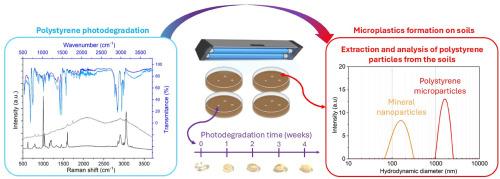Vibrational analysis of polystyrene photodegradation and its implications for microplastic formation in arid zones
IF 7.3
2区 环境科学与生态学
Q1 ENVIRONMENTAL SCIENCES
引用次数: 0
Abstract
This study examines the photodegradation of polystyrene as a potential source of microplastics (and nanoplastics) in arid soils. For this purpose, polystyrene pellets were exposed to UV-C radiation for different periods by placing them directly on soil collected from an arid region. The progressive degradation of the material was monitored weekly using Raman microscopy, Fourier transform infrared spectroscopy (FTIR), and Scanning Electron Microscopy (SEM). Spectroscopic analyses revealed chemical transformations associated with the photoinduced oxidation of polystyrene. Characteristic Raman peaks at 877 and 1732 cm−1 indicate the presence of hydroperoxide and ketone groups, respectively. The presence of an FTIR band at ∼3400 cm−1 further confirmed the formation of hydroperoxides. After the UV-C exposure period ended, the soil samples were processed to extract particles generated from the degraded polymer. Dynamic Light Scattering analysis indicated an average hydrodynamic size of 2388.88 ± 988.42 nm. Raman spectra of these particles confirmed the presence of polystyrene, while particles with an average size of 182.01 ± 34.58 nm were identified as common soil minerals (quartz, anatase, calcite, albite, and hematite). These findings enhance our understanding of the mechanisms driving microplastics formation under extreme environmental conditions and highlight key analytical tools for their detection and characterization in complex soil matrices.

干旱区聚苯乙烯光降解的振动分析及其对微塑料形成的影响
本研究考察了聚苯乙烯作为干旱土壤中微塑料(和纳米塑料)的潜在来源的光降解。为此,将聚苯乙烯颗粒直接放在从干旱地区收集的土壤上,在不同时期暴露在UV-C辐射下。每周使用拉曼显微镜、傅里叶变换红外光谱(FTIR)和扫描电子显微镜(SEM)监测材料的逐步降解。光谱分析揭示了与聚苯乙烯的光诱导氧化有关的化学转化。在877和1732 cm-1处的特征拉曼峰分别表示氢过氧化物和酮基的存在。在~ 3400 cm-1处的FTIR波段的存在进一步证实了氢过氧化物的形成。UV-C暴露期结束后,对土壤样品进行处理,提取降解聚合物产生的颗粒。动态光散射分析表明,其平均水动力尺寸为2388.88±988.42 nm。拉曼光谱证实了聚苯乙烯的存在,而平均粒径为182.01±34.58 nm的颗粒被鉴定为常见的土壤矿物(石英、锐钛矿、方解石、钠长石和赤铁矿)。这些发现增强了我们对极端环境条件下微塑料形成机制的理解,并强调了在复杂土壤基质中检测和表征微塑料的关键分析工具。
本文章由计算机程序翻译,如有差异,请以英文原文为准。
求助全文
约1分钟内获得全文
求助全文
来源期刊

Environmental Pollution
环境科学-环境科学
CiteScore
16.00
自引率
6.70%
发文量
2082
审稿时长
2.9 months
期刊介绍:
Environmental Pollution is an international peer-reviewed journal that publishes high-quality research papers and review articles covering all aspects of environmental pollution and its impacts on ecosystems and human health.
Subject areas include, but are not limited to:
• Sources and occurrences of pollutants that are clearly defined and measured in environmental compartments, food and food-related items, and human bodies;
• Interlinks between contaminant exposure and biological, ecological, and human health effects, including those of climate change;
• Contaminants of emerging concerns (including but not limited to antibiotic resistant microorganisms or genes, microplastics/nanoplastics, electronic wastes, light, and noise) and/or their biological, ecological, or human health effects;
• Laboratory and field studies on the remediation/mitigation of environmental pollution via new techniques and with clear links to biological, ecological, or human health effects;
• Modeling of pollution processes, patterns, or trends that is of clear environmental and/or human health interest;
• New techniques that measure and examine environmental occurrences, transport, behavior, and effects of pollutants within the environment or the laboratory, provided that they can be clearly used to address problems within regional or global environmental compartments.
 求助内容:
求助内容: 应助结果提醒方式:
应助结果提醒方式:


